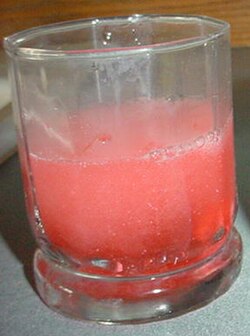This is an old revision of this page, as edited by 38.139.36.117 (talk) at 16:12, 11 November 2008 (→Popular Culture). The present address (URL) is a permanent link to this revision, which may differ significantly from the current revision.
Revision as of 16:12, 11 November 2008 by 38.139.36.117 (talk) (→Popular Culture)(diff) ← Previous revision | Latest revision (diff) | Newer revision → (diff)
Alka-Seltzer is a name owned by the German Bayer Corporation for a line of medications sold over the counter and taken by means of rapidly dissolving tablets that form an effervescent solution in water.
Product information
The original Alka-Seltzer was invented in 1931 and is a remedy for back aches, diarrhea, leg cramps, and heartburn. Sodium bicarbonate in Alka-Seltzer also makes it effective in treating mild blood acidosis associated with allergy (see citation). Alka-Seltzer is a combination of aspirin (acetylsalicylic acid, C9H8O4), sodium bicarbonate (NaHCO3), and citric acid (C6H8O7), designed to treat pain and simultaneously neutralize excess stomach acid (the "Alka" being derived from the word "alkali"). It is provided in the form of large effervescent tablets, about 1 inch (25 mm) in diameter, which are dissolved (two at a time for the usual adult dosage) in a glass of water. As the tablets dissolve, the base (bicarbonate) and the acid (citric acid) react vigorously producing carbon dioxide gas (hence the "Seltzer"), which also produces enough agitation to allow the active ingredients to dissolve slowly. The patient then ingests the resulting solution.
The product has been extensively advertised since the beginning of the mass media era in the U.S. It was formerly marketed as something of a cure-all; at one time its ads even suggested taking it for "the blahs." Subsequent regulation has taken into consideration that aspirin is a relatively powerful drug which is not tolerated by everyone and should not generally be taken at all by children or adolescents due to its linkage to Reye's syndrome; the product is no longer marketed in this fashion.
At one time the product was available in both long glass tubes and foil packets; the latter is the primary way the product is provided today, with two tablets in each packet.
As the sale of the original product has declined, Bayer HealthCare (formerly Miles Laboratories) has put the famous brand onto newer products, such as the Alka-Seltzer Plus line of remedies for the common cold. Some of the newer products are now neither effervescent nor aspirin-based. This is because the years spent building the brand through advertising are still yielding benefits; many Americans still remember catch phrases from its ads such as "I can't believe I ate the whole thing!", "Mamma mia, that's-a spicy meat-a-ball!", "Try it, you'll like it!" and "Plop, Plop, Fizz, Fizz, oh what a relief it is!"; a similar slogan in the United Kingdom referred to "plunk, plunk, fizz-ics".
Popular Culture
Alka Seltzer is briefly mentioned in the British band Oasis' song "Supersonic"
Alka Seltzer is referenced in an episode of the British sitcom, Black Books, in which Dylan Moran's character Bernard is hung over. The following exchange takes place:
Bernard: I went to the chemist to get some Fizzy-Good.
John Jacob Jinglehimer Shmit: Some what?
Bernard: You know, some Fizzy-Good, Fizzy-Good-Make-Feel-Nice.
John Jacob Jinglehimer Shmit: Oh, Alka-Seltzer.
Bernard: No, Fizzy-Good
Jack: You so fuuuuuuuuuunnnnnnnny!!!!
Bernard: Fizzy-Good is good
Chemistry of the effervescence
The aspirin (acetylsalicylic acid) is not an active ingredient in the effervescent action of Alka-Seltzer, but the baking soda (sodium bicarbonate) and citric acid are active.
| C6H8O7 | + | 3NaHCO3 | → | 3H2O | + | 3CO2 | + | Na3C6H5O7 |
| citric acid | + | baking soda | → | water | + | carbon dioxide | + | sodium citrate |
The carbon dioxide is released as a gas.
Notes
- Florida Institute of Technology. (Unknown). History of Radio. In http://www.lib.fit.edu/. Retrieved 3/7/08, from http://www.lib.fit.edu/pubs/librarydisplays/A%20History%20of%20Radio%20web%20site.htm.